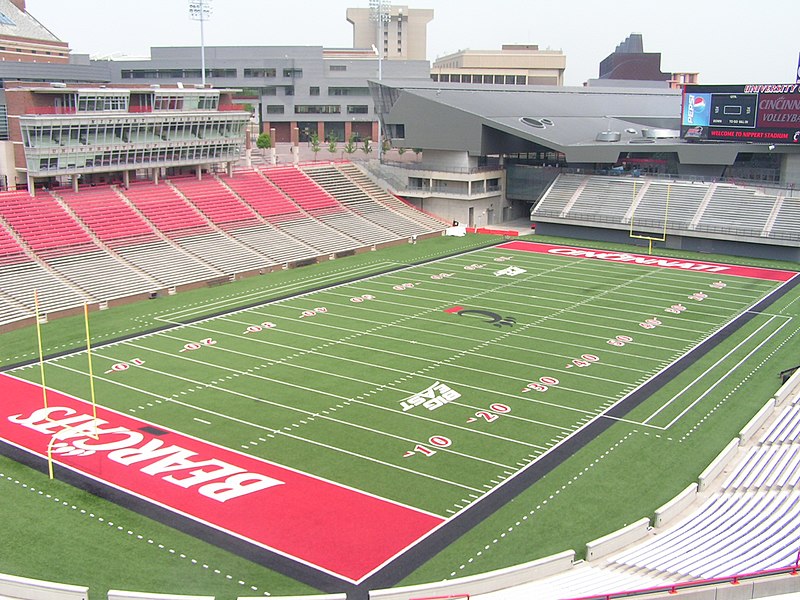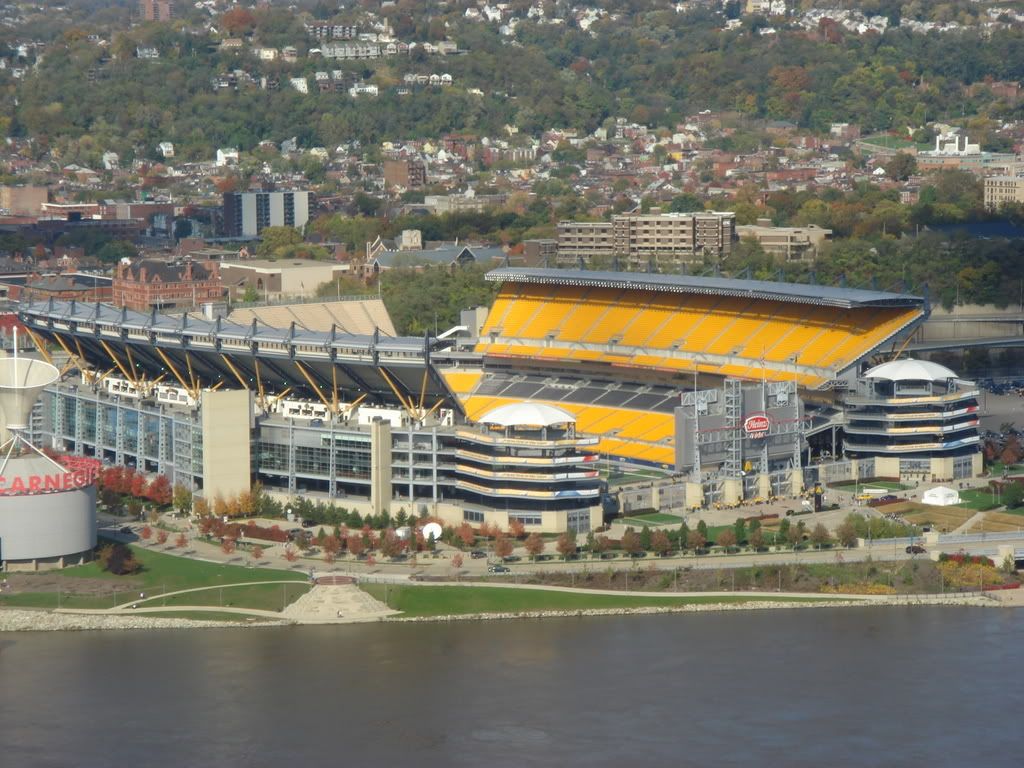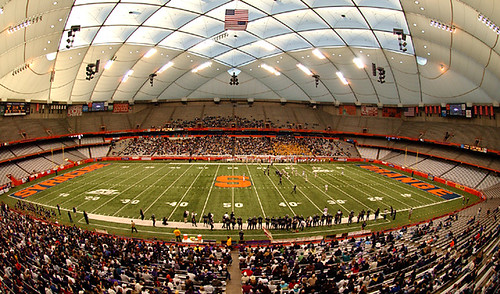Cincinnati: Nippert Stadium

Although it was renovated in 2005, Nippert Stadium is the fifth-oldest stadium in college football, being opened in 1924. And while it only houses 35 thousand fans, it is one of the prettiest, most architecturally-modern stadiums east of the Mississippi. Even though it is small, Nippert Stadium has a reputation for getting loud and rowdy, being nicknamed "The Zoo".
Standing since: 1924
Capacity: 35,097
Surface: FieldTurf
Location: On campus (Cincinnati, OH)
Traditions: Cincinnati played at Miami University (OH) in the first intercollegiate football game played in the state of Ohio in 1888. This started the oldest current non-conference college football rivalry in the United States. The RedHawks and the Bearcats have played 116 times, with Miami (OH) leading the series 59-50-7. The two rivals have played every year since 1945.
Connecticut: Rentschler Field

"The Rent" was opened in 2003, making it one of the newer stadiums in college football. Even with the new construction and harsh weather that occurs in Hartford every winter, the field is not turf; it is natural grass. Rentschler Field also plays host to the UFL's Hartford Colonials, who have been in existence since 2010.
Standing since: 2003
Capacity: 40,000
Surface: Grass
Location: On campus (Hartford, CT)
Traditions/facts: While the Huskies are relatively new to D-I football (having joined in 2002), they have been to five bowl games since becoming a member of the Big East in 2004. UConn has been to a bowl game every year since 2007, posting a 2-2 record in those four games.
Louisville: Papa John's Cardinal Stadium

Like UConn, Louisville has been a recent addition to the Big East, having joined in 2005. While the Cards have been playing D-I football since 1975, their new stadium was the second-to-last stadium opened in the 20th century (in the FBS), as the venue was opened in 1998. At the north end of the stadium is a statue of NFL great and Louisville grad Johnny Unitas. As the Cardinals march out onto the field before every home game, they touch the base of the bronze Unitas statue.
Standing since: 1998
Capacity: 55,000
Surface: FieldTurf
Location: On campus (Louisville, KY)
Traditions: All Cardinals touch the bronze Unitas statue before entering the field on gameday. After victories, the Cardinals take a 'victory lap' around the stadium, rejoicing with the Louisville faithful.
Pittsburgh: Heinz Field

Heinz Field is thought of, by many, as the Steelers' stadium. Little known is the healthy attendance that the venue attracts on Saturdays to watch Pitt Panther football. Although it is off-campus and considerably large for the size of the school (and football program), Heinz Field attracted just over 52 thousand Panther fans on gamedays in 2010. This means that the stadium is over 80% full on gamedays, which is quite a statistic considering the stadium's location relative to the Pitt campus.
Standing since: 2001
Capacity: 65,050
Surface: Grass
Location: Off-campus (Pittsburgh, PA)
Traditions: After every Panther touchdown, the Gateway Clipper, a riverboat fleet that runs just outside of the stadium (on the Allegheny River), sound its' horns.
Rutgers: High Point Solutions Stadium

Formerly known as "Rutgers Stadium", this venue was just renamed at the start of the 2011 season. While it hosts one of the oldest football programs in the nation, this stadium was constructed in 1994. It currently sits where the old Rutgers Stadium (built in 1938) used to be. After every Scarlet Knight touchdown a cannon sounds, and the stadium overlooks the beautiful Raritan River.
Standing since: 1994
Capacity: 52,454
Surface: FieldTurf
Location: On campus (Piscataway, NJ)
Traditions/fun facts: Rutgers has been playing football since 1869. The Scarlet Knight's only national championship was in 1869, when they shared the title with Princeton.
South Florida: Raymond James Stadium

This is another Big East stadium that is shared with an NFL team, as Raymond James Stadium houses both the Bulls and the NFL's Buccaneers. USF is one of the newer programs in the country, having hatched in 1997 as an FCS school (the Bulls went FBS in 2001). While not much tradition lies with this new program playing in another team's stadium, the team has been competitive, as they have went to a bowl game five years in a row (and counting).
Standing since: 1998
Capacity: 65,857
Surface: Grass
Location: Off-campus (Tampa, FL)
Traditions: No rivals yet, but the Bulls start a 6-year series of Thanksgiving weekend games versus the nearby Miami Hurricanes this year. This could very well be the spark that lights a new south-Floridan rivalry.
Syracuse: Carrier Dome

The Carrier Dome is the largest domed stadium on any college campus in the U.S. It hosts the New York high school football championships, and was nicknamed "The Loud House" because of the noise that stays contained inside the well-insulated dome during Orange home games.
Standing since: 1980
Capacity: 49,250
Surface: FieldTurf
Location: On campus (Syracuse, NY)
Traditions/fun facts: The field was dedicated to Ernie Davis, the first African-American Heisman Trophy-winner, in 2009 (Davis was a Syracuse alum). "Ernie Davis Legends Field" is now printed near the 50-yard line on the turf. Davis's number 44 is retired in the rafters of the dome.
West Virginia: Mountaineer Field (at Milan Puskar Stadium)

Like Cincinnati's Nippert Stadium, Mountaineer Field is an older venue that has been renovated. This venue was renovated in 2007, as the university added new turf and updated endzone seating. The Mountaineer mascot fires his musket before every game, and the marching band forms the outline of West Virginia while playing the fight song before kickoff. While Pitt and South Florida both play at NFL stadiums, Mountaineer Field is still the largest venue in the Big East, holding 60,000 fans. Next year, West Virginia will be playing in the Big 12 conference, and will likely lose old rivalry games against Pitt, Louisville, and Cincinnati.
Standing since: 1980 (just twelve days older than the Carrier Dome)
Capacity: 60,000
Surface: FieldTurf
Location: On campus (Morgantown, WV)
Traditions: Mountaineer mascot fires musket before kickoff, band forms state outline while playing fight song, frequent 'gold-outs' at night games.
THE AWARDS:
Ranking the Big East's stadiums in many different categories.

Biggest stadium:
1. West Virginia
2. South Florida
3. Pittsburgh
4. Louisville
5. Rutgers
6. Syracuse
7. Connecticut
8. Cincinnati

Oldest stadium:
1. Cincinnati (before renovations)
2. West Virginia
3. Syracuse
4. Rutgers
5. Louisville
6. South Florida
7. Pittsburgh
8. Connecticut
 Best tradition/fun fact:
Best tradition/fun fact:
1. West Virginia (Mountaineer musket)
2. Cincinnati (Miami rivalry)
3. Pittsburgh (Gateway Clipper)
4. Louisville (Unitas statue)
5. Syracuse (Ernie Davis)
6. Rutgers (since 1869)
7. Connecticut (none)
8. South Florida (even less)
Prettiest stadium:
1. Cincinnati
2. Syracuse
3. Pittsburgh
4. Rutgers
5. Louisville
6. West Virginia
7. Connecticut
8. South Florida

Best endzone design:
1. Louisville
2. Syracuse
3. Cincinnati
4. Connecticut
5. Rutgers
6. West Virginia
7. South Florida
8. Pittsburgh

Best stadium (overall):
1. West Virginia
2. Syracuse
3. Rutgers
4. Cincinnati
5. Louisville
6. Connecticut
7. Pittsburgh
8. South Florida
On a side note...
3/8 Big East fields were grass, the rest were FieldTurf
All stadiums were on-campus except for two, South Florida and Pittsburgh (both stadiums are shared with local NFL teams)
The oldest stadium was opened in 1924 (Cincinnati), while the newest stadium was opened in 2003 (Connecticut).

"The Rent" was opened in 2003, making it one of the newer stadiums in college football. Even with the new construction and harsh weather that occurs in Hartford every winter, the field is not turf; it is natural grass. Rentschler Field also plays host to the UFL's Hartford Colonials, who have been in existence since 2010.
Standing since: 2003
Capacity: 40,000
Surface: Grass
Location: On campus (Hartford, CT)
Traditions/facts: While the Huskies are relatively new to D-I football (having joined in 2002), they have been to five bowl games since becoming a member of the Big East in 2004. UConn has been to a bowl game every year since 2007, posting a 2-2 record in those four games.
Louisville: Papa John's Cardinal Stadium
Like UConn, Louisville has been a recent addition to the Big East, having joined in 2005. While the Cards have been playing D-I football since 1975, their new stadium was the second-to-last stadium opened in the 20th century (in the FBS), as the venue was opened in 1998. At the north end of the stadium is a statue of NFL great and Louisville grad Johnny Unitas. As the Cardinals march out onto the field before every home game, they touch the base of the bronze Unitas statue.
Standing since: 1998
Capacity: 55,000
Surface: FieldTurf
Location: On campus (Louisville, KY)
Traditions: All Cardinals touch the bronze Unitas statue before entering the field on gameday. After victories, the Cardinals take a 'victory lap' around the stadium, rejoicing with the Louisville faithful.
Pittsburgh: Heinz Field

Heinz Field is thought of, by many, as the Steelers' stadium. Little known is the healthy attendance that the venue attracts on Saturdays to watch Pitt Panther football. Although it is off-campus and considerably large for the size of the school (and football program), Heinz Field attracted just over 52 thousand Panther fans on gamedays in 2010. This means that the stadium is over 80% full on gamedays, which is quite a statistic considering the stadium's location relative to the Pitt campus.
Standing since: 2001
Capacity: 65,050
Surface: Grass
Location: Off-campus (Pittsburgh, PA)
Traditions: After every Panther touchdown, the Gateway Clipper, a riverboat fleet that runs just outside of the stadium (on the Allegheny River), sound its' horns.
Rutgers: High Point Solutions Stadium

Formerly known as "Rutgers Stadium", this venue was just renamed at the start of the 2011 season. While it hosts one of the oldest football programs in the nation, this stadium was constructed in 1994. It currently sits where the old Rutgers Stadium (built in 1938) used to be. After every Scarlet Knight touchdown a cannon sounds, and the stadium overlooks the beautiful Raritan River.
Standing since: 1994
Capacity: 52,454
Surface: FieldTurf
Location: On campus (Piscataway, NJ)
Traditions/fun facts: Rutgers has been playing football since 1869. The Scarlet Knight's only national championship was in 1869, when they shared the title with Princeton.
South Florida: Raymond James Stadium

This is another Big East stadium that is shared with an NFL team, as Raymond James Stadium houses both the Bulls and the NFL's Buccaneers. USF is one of the newer programs in the country, having hatched in 1997 as an FCS school (the Bulls went FBS in 2001). While not much tradition lies with this new program playing in another team's stadium, the team has been competitive, as they have went to a bowl game five years in a row (and counting).
Standing since: 1998
Capacity: 65,857
Surface: Grass
Location: Off-campus (Tampa, FL)
Traditions: No rivals yet, but the Bulls start a 6-year series of Thanksgiving weekend games versus the nearby Miami Hurricanes this year. This could very well be the spark that lights a new south-Floridan rivalry.
Syracuse: Carrier Dome

The Carrier Dome is the largest domed stadium on any college campus in the U.S. It hosts the New York high school football championships, and was nicknamed "The Loud House" because of the noise that stays contained inside the well-insulated dome during Orange home games.
Standing since: 1980
Capacity: 49,250
Surface: FieldTurf
Location: On campus (Syracuse, NY)
Traditions/fun facts: The field was dedicated to Ernie Davis, the first African-American Heisman Trophy-winner, in 2009 (Davis was a Syracuse alum). "Ernie Davis Legends Field" is now printed near the 50-yard line on the turf. Davis's number 44 is retired in the rafters of the dome.
West Virginia: Mountaineer Field (at Milan Puskar Stadium)

Like Cincinnati's Nippert Stadium, Mountaineer Field is an older venue that has been renovated. This venue was renovated in 2007, as the university added new turf and updated endzone seating. The Mountaineer mascot fires his musket before every game, and the marching band forms the outline of West Virginia while playing the fight song before kickoff. While Pitt and South Florida both play at NFL stadiums, Mountaineer Field is still the largest venue in the Big East, holding 60,000 fans. Next year, West Virginia will be playing in the Big 12 conference, and will likely lose old rivalry games against Pitt, Louisville, and Cincinnati.
Standing since: 1980 (just twelve days older than the Carrier Dome)
Capacity: 60,000
Surface: FieldTurf
Location: On campus (Morgantown, WV)
Traditions: Mountaineer mascot fires musket before kickoff, band forms state outline while playing fight song, frequent 'gold-outs' at night games.
THE AWARDS:
Ranking the Big East's stadiums in many different categories.

Biggest stadium:
1. West Virginia
2. South Florida
3. Pittsburgh
4. Louisville
5. Rutgers
6. Syracuse
7. Connecticut
8. Cincinnati

Oldest stadium:
1. Cincinnati (before renovations)
2. West Virginia
3. Syracuse
4. Rutgers
5. Louisville
6. South Florida
7. Pittsburgh
8. Connecticut
 Best tradition/fun fact:
Best tradition/fun fact:1. West Virginia (Mountaineer musket)
2. Cincinnati (Miami rivalry)
3. Pittsburgh (Gateway Clipper)
4. Louisville (Unitas statue)
5. Syracuse (Ernie Davis)
6. Rutgers (since 1869)
7. Connecticut (none)
8. South Florida (even less)
Prettiest stadium:
1. Cincinnati
2. Syracuse
3. Pittsburgh
4. Rutgers
5. Louisville
6. West Virginia
7. Connecticut
8. South Florida

Best endzone design:
1. Louisville
2. Syracuse
3. Cincinnati
4. Connecticut
5. Rutgers
6. West Virginia
7. South Florida
8. Pittsburgh

Best stadium (overall):
1. West Virginia
2. Syracuse
3. Rutgers
4. Cincinnati
5. Louisville
6. Connecticut
7. Pittsburgh
8. South Florida
On a side note...
3/8 Big East fields were grass, the rest were FieldTurf
All stadiums were on-campus except for two, South Florida and Pittsburgh (both stadiums are shared with local NFL teams)
The oldest stadium was opened in 1924 (Cincinnati), while the newest stadium was opened in 2003 (Connecticut).
No comments:
Post a Comment